Choosing the best dry cat food is one of the most important decisions you can make for your cat’s health. With so many options available, from grain-free formulas to high-protein blends, finding the right one can feel overwhelming. Cats have unique nutritional needs, and not all dry cat food brands provide the right balance of protein, vitamins, and essential nutrients like taurine. A poor diet can lead to health issues such as obesity, digestive problems, and even heart disease.
Understanding what makes a high-quality dry cat food can help you make a better choice for your feline friend. Factors like protein content, ingredient quality, and vet recommendations play a huge role in selecting a nutritious and balanced diet. Some cats require specialized formulas, such as food for sensitive stomachs or weight management, while others thrive on high-protein, low-carb options.
In this guide, we’ll break down everything you need to know about choosing the best dry cat food. We’ll cover key nutritional factors, top brands, and how different formulas cater to specific needs. Whether you’re looking for an affordable option, a vet-approved brand, or a natural dry cat food, this article will help you find the perfect fit for your cat’s health and lifestyle.
Key Factors to Consider When Choosing Dry Cat Food
Protein Content & Taurine: Essential Nutrients for Your Cat’s Health
Cats are obligate carnivores, meaning they require a diet rich in animal-based protein to stay healthy. When selecting dry cat food, always check the protein percentage on the label. A high-quality option should contain at least 30–40% protein, sourced from real meat like chicken, turkey, fish, or beef. Avoid products that rely heavily on plant-based proteins like peas or soy, as these don’t provide the essential amino acids cats need.
Taurine is one of the most critical nutrients in a cat’s diet. This amino acid, naturally found in animal proteins, supports heart function, vision, and immune health. Unlike some other animals, cats cannot produce enough taurine on their own, so they must get it from their food. A deficiency can lead to serious health problems, including heart disease and blindness. Always check the ingredients list to ensure taurine is included in your dry cat food for optimal feline health.
Grain-Free vs. Regular: Which One is Better?
Many cat owners wonder whether grain-free food is a healthier choice. While grain-free diets have gained popularity, they aren’t always necessary. These formulas remove ingredients like wheat, corn, and soy, replacing them with alternatives such as peas, lentils, or potatoes. Cats with grain allergies or sensitivities may benefit from grain-free dry cat food, as these diets can help reduce digestive issues and skin irritation.
However, grain-free doesn’t automatically mean better. Some formulas use too many plant-based ingredients, reducing the overall protein content. If a cat doesn’t have a grain allergy, a high-quality regular formula with whole grains like brown rice or oatmeal can still provide a balanced diet. Instead of focusing solely on whether a product is grain-free, pay attention to the overall ingredient quality and protein sources when selecting dry cat food.
AAFCO Standards: Why They Matter
When selecting food, always look for the AAFCO (Association of American Feed Control Officials) statement on the packaging. AAFCO sets nutritional standards to ensure pet foods provide complete and balanced nutrition. Foods that meet these guidelines have been formulated or tested to contain the right balance of protein, fats, vitamins, and minerals that cats need. Choosing an AAFCO-approved dry cat food ensures that your cat receives a well-balanced diet that meets its nutritional requirements.
Not all brands meet AAFCO standards, so it’s important to read labels carefully. Foods that comply with these guidelines will indicate whether they are formulated for “growth and reproduction” (kittens and pregnant/nursing cats) or “adult maintenance” (fully grown cats). Some premium brands also conduct feeding trials, meaning real cats have tested the food to confirm its nutritional adequacy. Checking for AAFCO compliance ensures that your dry cat food meets industry standards for feline nutrition.
By paying attention to protein content, taurine levels, and AAFCO certification, cat owners can make an informed decision when choosing the right dry cat food for their feline companion.
Best Dry Cat Food for Different Needs
Best for Indoor Cats: Nutritional Needs and Ideal Ingredients
Indoor cats tend to be less active than their outdoor counterparts, which means they require a well-balanced diet that supports weight management while providing all essential nutrients. The best dry cat food for indoor cats contains moderate calories, high-quality protein, and fiber to aid digestion and reduce hairballs. Since indoor cats are more prone to obesity, choosing a formula with controlled fat levels and L-carnitine can help maintain a healthy weight.
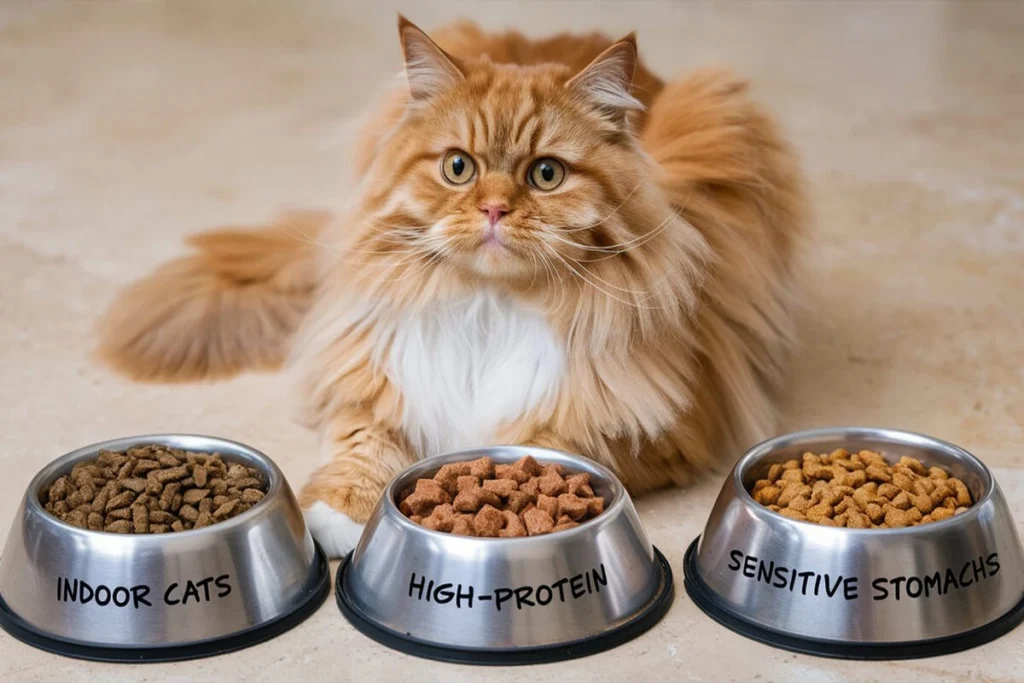
In addition to weight control, fiber-rich ingredients like beet pulp, psyllium husk, or pumpkin can help with digestion and hairball prevention. Some indoor formulas also include omega-3 and omega-6 fatty acids, which promote a shiny coat and healthy skin. Always ensure that the dry cat food you choose meets AAFCO standards and provides a complete and balanced diet for your feline companion.
High-Protein & Low-Carb Options: Benefits for Active and Overweight Cats
Cats thrive on a diet that mimics their natural carnivorous instincts, making high-protein, low-carb food an excellent choice for many felines. A high-protein dry cat food provides sustained energy, supports muscle maintenance, and helps with weight management. It’s particularly beneficial for highly active cats, overweight felines, or those prone to diabetes.
Carbohydrates aren’t a necessary part of a cat’s diet, and excessive carbs can lead to weight gain and blood sugar spikes. When choosing a low-carb formula, look for one that prioritizes real meat as the primary ingredient while avoiding fillers like corn, wheat, and soy. Some of the best high-protein options include formulas with over 40% protein content, sourced from quality ingredients such as chicken, fish, or turkey. Ensuring that your dry cat food follows these guidelines will provide the right balance of nutrients for your cat’s lifestyle.
Dry Cat Food for Sensitive Stomachs: Gentle Nutrition for Digestive Health
Some cats struggle with digestive issues like vomiting, diarrhea, or excessive gas. These symptoms may indicate food sensitivities. Choosing dry cat food for sensitive stomachs can help ease discomfort while maintaining balanced nutrition. Limited-ingredient diets and easily digestible proteins, like turkey, duck, or hydrolyzed protein, are gentler on digestion.
Prebiotics and probiotics support gut health. Look for ingredients like chicory root, pumpkin, or added probiotics. Avoid artificial additives, excessive fillers, and allergens like dairy or soy. These can trigger digestive upset and discomfort in sensitive cats.
If stomach issues persist, switching to a specialized dry cat food may improve digestion and overall health. The right formula ensures your cat gets the nutrition they need without unnecessary stomach distress.
Popular Vet-Recommended Dry Cat Food Brands
Purina & Hill’s Science Diet: Trusted Brands with Vet-Recommended Formulas
Purina and Hill’s Science Diet are two of the most trusted names in pet nutrition. Both brands focus on scientifically formulated recipes backed by years of research. Veterinarians often recommend them because of their commitment to high-quality ingredients and feline health.
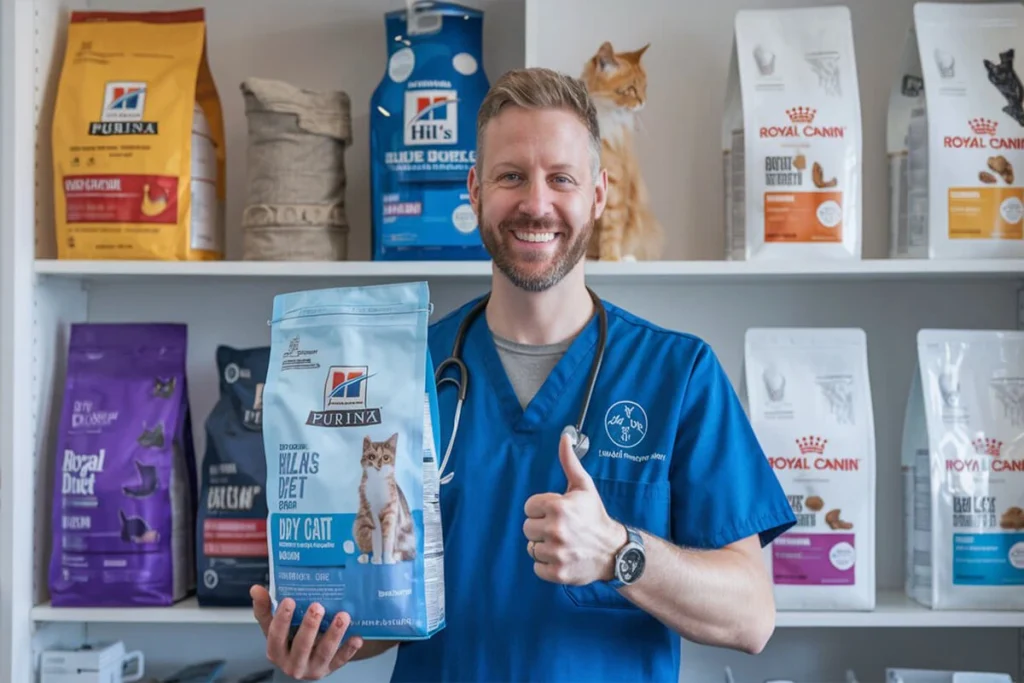
Purina offers a variety of formulas for different dietary needs. The Pro Plan line features real meat as the first ingredient and includes probiotics for digestive health. Purina ONE provides high-protein options with omega fatty acids to support skin and coat health. Beyond, their natural product line, avoids artificial preservatives and flavors. Whether your cat needs weight management, hairball control, or sensitive stomach support, Purina has options to match.
Hill’s Science Diet takes a research-driven approach to feline nutrition. Developed by veterinarians and nutritionists, its formulas support cats at every life stage. Hill’s is well known for its prescription diets, which help with kidney disease, urinary health, and food sensitivities. It focuses on digestibility, ensuring cats absorb essential nutrients efficiently. With high-quality ingredients and no artificial additives, Hill’s provides a reliable option for science-backed nutrition.
If you want dry cat food with proven research and top-tier ingredients, Purina and Hill’s Science Diet offer excellent choices. Both brands cater to a wide range of feline dietary needs.
Blue Buffalo & Royal Canin: Premium Nutrition for Cats with Specific Needs
Blue Buffalo and Royal Canin are premium brands that focus on high-quality ingredients and specialized formulas for different feline health concerns. While Blue Buffalo emphasizes natural ingredients and grain-free options, Royal Canin is known for its breed-specific and prescription diets designed for medical needs.
Blue Buffalo is famous for its natural approach to pet nutrition. Unlike many commercial brands, Blue Buffalo avoids poultry by-product meals, artificial preservatives, and fillers. Instead, it uses high-quality protein sources like deboned chicken, fish, or turkey. One of the brand’s signature features is its LifeSource Bits—a proprietary blend of vitamins, minerals, and antioxidants designed to support immune health, digestion, and overall well-being. The Wilderness line, inspired by a cat’s natural diet, is rich in protein and low in carbohydrates, making it an excellent option for active or overweight felines.
Royal Canin, on the other hand, specializes in precise, scientifically formulated nutrition. The brand offers breed-specific diets tailored to the unique needs of Persian, Maine Coon, Siamese, and other cat breeds. Beyond breed-specific formulas, Royal Canin also provides veterinary prescription diets for cats with urinary tract issues, kidney disease, diabetes, and digestive disorders. Its focus on precise nutrient ratios ensures that cats receive optimal nourishment based on their unique physiological needs.
If your cat requires dry cat food that supports a specific health condition or breed-related needs, Blue Buffalo and Royal Canin offer specialized solutions designed to enhance overall feline wellness.
IAMS & Affordable Alternatives: Budget-Friendly Yet Nutritious Options
IAMS is a widely recognized brand that offers high-quality cat food at an affordable price. While it may not have the same premium ingredients as boutique brands, IAMS provides balanced nutrition with real meat as the first ingredient, essential vitamins and minerals, and a focus on digestive health.
IAMS formulas include fiber-rich prebiotics to support gut health, omega fatty acids for skin and coat health, and added taurine for heart and vision support. Many of its formulas are designed to promote strong muscles, healthy digestion, and immune system support. The ProActive Health line, for example, contains high-quality protein from chicken or salmon, along with essential nutrients like L-carnitine to help maintain a healthy weight.
For pet owners looking for even more budget-friendly options, brands like Purina Cat Chow, Friskies, and Meow Mix offer economical choices that still meet AAFCO’s nutritional standards. While these brands may contain more fillers like corn, wheat, and soy compared to premium options, they still provide adequate protein and essential nutrients for daily feline nutrition.
If you’re selecting an affordable dry cat food, focus on options with real meat as the first ingredient and avoid excessive artificial additives. Even on a budget, it’s possible to find nutritious options that keep your cat healthy and satisfied.
By choosing a brand that aligns with your cat’s dietary needs and your budget, you can provide quality nutrition without overspending.
Health Benefits of Dry Cat Food
Dental Health: How Dry Cat Food Supports Oral Hygiene
A cat’s dental health plays a crucial role in overall well-being, and diet can significantly impact oral hygiene. Unlike wet food, dry cat food has a crunchy texture that helps reduce plaque and tartar buildup as cats chew. The mechanical action of biting into kibble scrapes the teeth, promoting cleaner gums and fresher breath. Some formulas even include specially designed kibble shapes that encourage chewing, further aiding in plaque control.
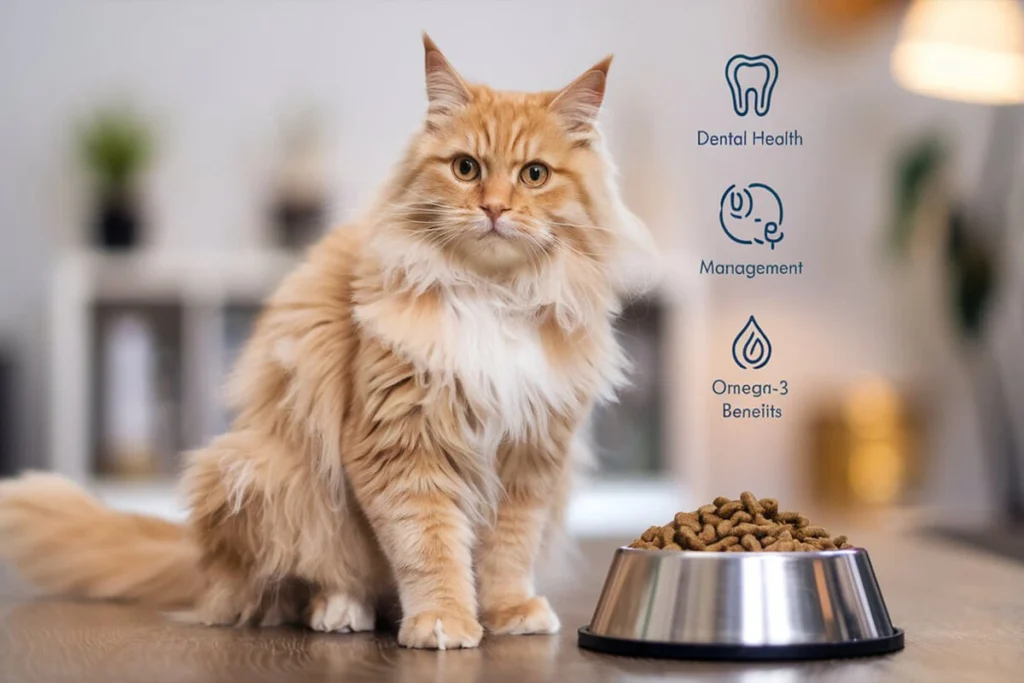
Certain brands offer dental-specific formulas that contain enzymes or additives to help prevent bacteria from sticking to the teeth. Ingredients such as sodium hexametaphosphate or specialized fiber blends can slow tartar accumulation, reducing the risk of gum disease. While dry cat food can contribute to better dental health, it’s still essential to incorporate regular brushing and professional cleanings for optimal oral care.
For cats prone to dental issues, choosing a formula designed for oral health can make a difference. Look for products with the Veterinary Oral Health Council (VOHC) seal, indicating they meet specific standards for reducing plaque and tartar buildup. A well-chosen dry cat food can serve as a valuable tool in maintaining your cat’s dental hygiene and overall health.
Weight Management: Finding the Right Balance for a Healthy Cat
Obesity is a common issue among house cats, leading to serious health risks such as diabetes, joint problems, and heart disease. Managing a cat’s weight starts with selecting the right dry cat food, which should provide balanced nutrition without excessive calories.
Weight management formulas typically contain fewer calories but maintain high protein levels to support muscle mass. These formulas often include L-carnitine, an amino acid that helps convert fat into energy and promotes a healthy metabolism. Fiber is another key component, as it increases satiety, helping cats feel full for longer periods and reducing overeating. Ingredients like beet pulp, psyllium husk, and cellulose can aid digestion and prevent weight gain by keeping cats satisfied between meals.
Portion control also plays a vital role in maintaining a healthy weight. Even with a specialized dry cat food, measuring meals and avoiding free feeding can prevent unnecessary weight gain. If your cat struggles with obesity, choosing a vet-recommended weight management formula and implementing a structured feeding routine can significantly improve their health and longevity.
Omega-3 & Omega-6 Fatty Acids: Essential Nutrients for Skin, Coat, and Overall Health
Omega-3 and Omega-6 fatty acids are essential nutrients that contribute to a cat’s overall health, particularly skin, coat, joint, and brain function. These fatty acids cannot be produced by a cat’s body and must be obtained through diet, making it important to select a dry cat food that contains high-quality sources.
Omega-3 fatty acids, found in fish oil, flaxseed, and certain algae, have anti-inflammatory properties that support heart health, brain function, and joint mobility. These nutrients are especially beneficial for older cats or those with arthritis, as they help reduce inflammation and improve mobility. Omega-3s also promote a shiny coat and prevent dry, itchy skin.
Omega-6 fatty acids, sourced from poultry fat, sunflower oil, and safflower oil, play a crucial role in skin hydration and coat health. They help maintain a soft, glossy fur texture while strengthening the skin barrier against allergens and irritants. The right balance between Omega-3 and Omega-6 fatty acids is essential—too much Omega-6 without enough Omega-3 can lead to inflammation.
When selecting dry cat food, look for formulas that include natural sources of these essential fatty acids. A diet rich in the right fats can enhance your cat’s skin health, coat quality, and overall well-being, ensuring they look and feel their best.
By choosing a diet that supports dental health, weight management, and essential fatty acid intake, cat owners can significantly improve their pet’s quality of life.
Final Tips for Selecting the Best Dry Cat Food
Check the Ingredients List: Understanding What’s in Your Cat’s Food
Choosing the right dry cat food starts with carefully examining the ingredients list. The quality of ingredients directly affects a cat’s health, energy levels, and overall well-being. Look for real meat, such as chicken, turkey, or fish, as the first ingredient. Cats are obligate carnivores, meaning their diet should be primarily animal-based protein rather than fillers like corn, wheat, or soy.
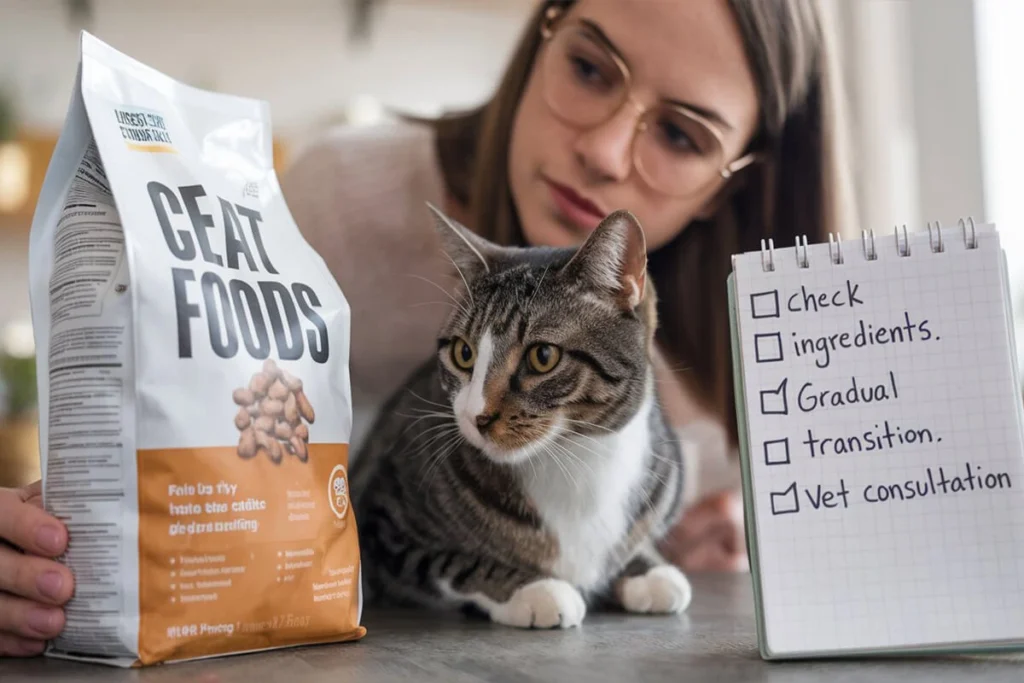
Avoid artificial preservatives, colors, and flavors, which can cause unnecessary strain on a cat’s digestive system. Instead, opt for natural preservatives like mixed tocopherols (a source of vitamin E) and rosemary extract. Added vitamins and minerals, including taurine, calcium, and omega fatty acids, contribute to heart health, strong bones, and a shiny coat.
If your cat has specific dietary needs, consider additional factors such as grain-free formulas for allergies, high-protein options for active cats, or limited-ingredient diets for sensitive stomachs. Reading the label ensures that you’re providing balanced, nutritious dry cat food that meets AAFCO standards for complete feline nutrition.
Transitioning to a New Dry Food: How to Switch Without Upsetting Digestion
Switching your cat to a new dry cat food requires a gradual transition to prevent digestive upset. Cats have sensitive stomachs, and sudden changes in diet can lead to vomiting, diarrhea, or refusal to eat. To ensure a smooth transition, mix the new food with the old food over a period of 7–10 days.
Start by replacing about 25% of the old food with the new food, gradually increasing the proportion every few days. By day five, aim for a 50/50 mix, and by day ten, your cat should be fully transitioned to the new diet. If your cat shows signs of digestive discomfort, slow down the transition process and give their stomach more time to adjust.
Some cats are picky eaters and may be reluctant to try a new dry cat food. To encourage them, try adding a small amount of warm water, a teaspoon of wet food, or a sprinkle of freeze-dried meat toppers. Patience and consistency will help make the transition easier, ensuring your cat gets accustomed to their new diet without stress.
Consulting a Vet: The Importance of Professional Guidance in Choosing Food
Every cat has unique nutritional needs, and while researching dry cat food is essential, consulting a veterinarian is the best way to ensure you’re making the right choice. A vet can assess your cat’s age, weight, activity level, and any underlying health conditions to recommend the most suitable diet.
For cats with specific medical concerns—such as diabetes, kidney disease, allergies, or digestive disorders—a vet may suggest prescription diets tailored to those conditions. They can also help identify any food sensitivities if your cat experiences frequent vomiting, diarrhea, or skin issues.
Regular checkups provide an opportunity to discuss any dietary adjustments based on your cat’s changing needs. As they age, their metabolism, weight, and overall health may shift, requiring a different formula for optimal nutrition. Even if your cat appears healthy, a vet-approved dry cat food selection can help prevent future health problems and promote long-term well-being.
By carefully checking ingredient labels, transitioning gradually, and consulting a veterinarian when needed, cat owners can ensure their feline friends receive the best possible nutrition for a healthy and happy life.
Conclusion
Selecting the best dry cat food requires careful thought about your cat’s diet, ingredient quality, and overall health. With so many choices, focus on high-quality protein, taurine, and omega fatty acids. Choose a formula that matches your cat’s age, lifestyle, and health conditions.
If your cat lives indoors, look for food that supports weight control and digestion. Active or growing cats need high-protein, low-carb options for muscle growth and energy. Cats with allergies may benefit from grain-free or limited-ingredient diets. A balanced diet improves dental health, skin, coat, and overall well-being.
Switching to a new dry cat food takes time. Gradually introduce it to avoid stomach issues and encourage acceptance. Monitor your cat’s response and check for better energy, digestion, and coat quality. If problems persist, talk to a vet for guidance.
A proper diet does more than satisfy hunger—it ensures lifelong health. Whether you pick a premium brand like Royal Canin or an affordable one like IAMS, good nutrition keeps your cat happy and active. The right food supports their health and gives them the quality of life they deserve.
What’s The Best Food Ever For Your Lovely Cat? Full Guide!
What is the Acceptable Reasons To Rehome a Cat: 10 Best Tips in this Article!
Do Cats Really Love Cakes, Find Out Here!
Get Some Good Stuff for your Cat From Pet MD Official
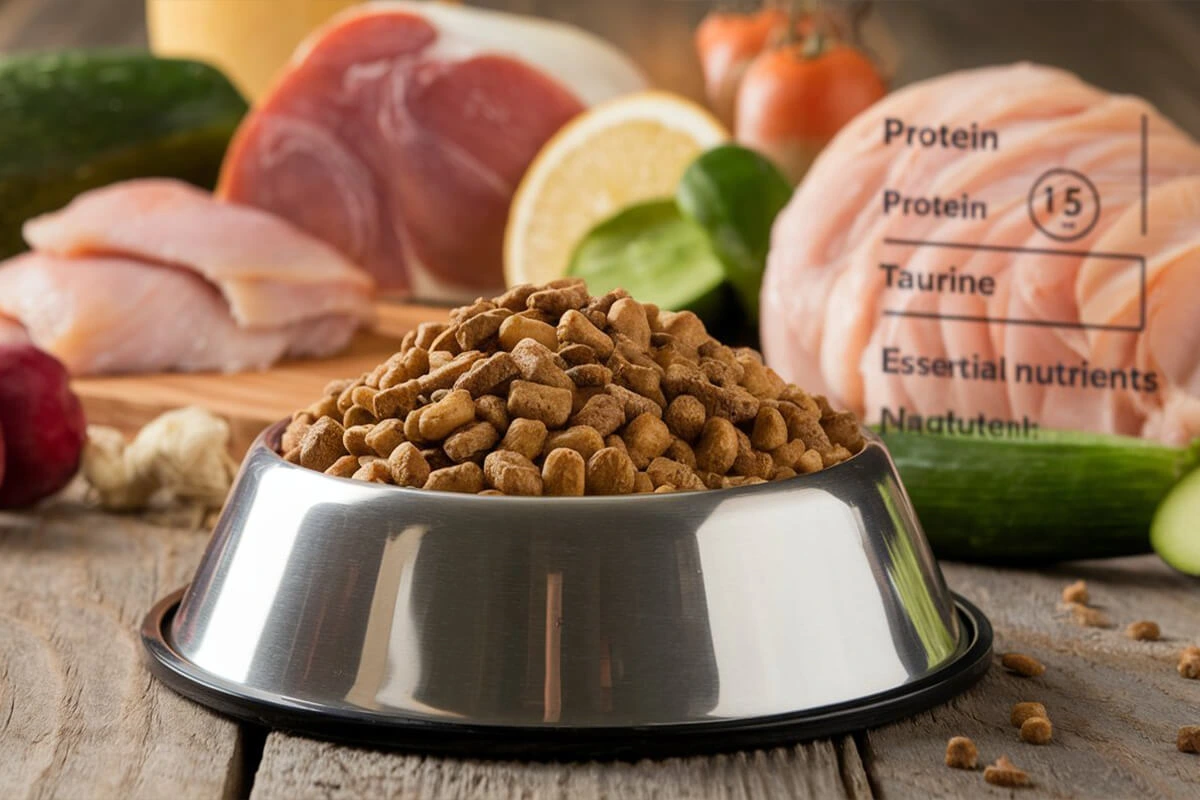
1 thought on “What’s the Best Dry Cat Food? What Every Owner needs To know”
Comments are closed.